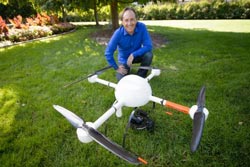MSU lands first drone

Farmers can now get a birds-eye view of their fields – in full HD – thanks to Michigan State University landing its first drone. Courtesy of G.L. Kohuth<br>
MSU researchers are using its first unmanned aerial vehicle to help farmers maximize yields by improving nitrogen and water management and reducing environmental impact such as nitrate leaching or nitrous oxide emissions.
For this initiative, MSU’s UAV measures how crops react to stress, such as drought, nutrients deficiency or pests. The drone flies over the field documenting the field’s status – down to centimeters. The portrait gives farmers details on the current health of their crops.
Armed with this knowledge, farmers can quickly pinpoint problem areas and address them with a precise rifle, as opposed to, a shotgun approach, said Bruno Basso, MSU ecosystem scientist.
“When you have a cut and need disinfectant, you don’t dive into a pool of medicine; you apply it only where you need it and in the quantity that is strictly necessary,” said Bruno, who is also a professor at MSU’s Kellogg Biological Station. “Rather than covering the entire field with fertilizer, it can be applied exactly where it’s needed. We basically try to do the right thing, at right place, at the right time”
The UAV has three sensors: a high-resolution radiometer; a thermal camera, used to monitor plant temperature and hydration; and a laser scanner, which measures individual plant height in centimeters. Unlike planes, the drone can fly at low altitudes (less than 100 feet) and in most weather conditions as long it is not very windy, covers a pre-programmed pattern on autopilot and provides more accurate data in a cost-effective manner.
“The UAV is like an X-ray,” Basso said. “Before we can diagnose the problem, we need to collect as many details as possible.”
The response to light varies among plants based on their health. Through combinations of spectral reflectance bands, researchers can determine the plants’ main source of stress, such as water or nitrogen.
With X-rays in hand, Basso, part of MSU’s Global Water Initiative, can plug in the data into the System Approach for Land-Use Sustainability model. SALUS is a new generation crop tool to forecast crop, soil, water, and nutrient conditions in current and future climates. It also can evaluate crop rotations, planting dates, irrigation and fertilizer use and project crop yields and their impact on the land.
The combination of drone and SALUS allows farmers to maximize their efforts in a sustainable fashion. They can distinguish plants that need water or nitrogen, and treat their plants – rather than their entire field – immediately.
“It’s based on actual need, not on tradition, not on history or a plan recommended by someone else,” Basso said. “It’s what plants need now and is the ultimate in sustainability.”
This isn’t scientific theory, either. This is what’s happening in the farmers’ own fields, playing out in terms of profit per acre and preserving their environment, rather than in laboratories.
“You have to use technology to help improve people’s lives,” Basso said. “The combination of UAV and SALUS is powerful and accessible.”
Deploying the UAV to aid farmers is serving as the inaugural use of MSU’s drone. Basso is open to sharing it with others and collaborating on new research. The potential of drones has yet to be maximized, he said.
Basso’s research is funded in part by the National Science Foundation.
Media Contact
More Information:
http://www.msu.eduAll latest news from the category: Agricultural and Forestry Science
Newest articles

Compact LCOS Microdisplay with Fast CMOS Backplane
…for High-Speed Light Modulation. Researchers from the Fraunhofer Institute for Photonic Microsystems IPMS, in collaboration with HOLOEYE Photonics AG, have developed a compact LCOS microdisplay with high refresh rates that…

New perspectives for material detection
CRC MARIE enters third funding period: A major success for terahertz research: Scientists at the University of Duisburg-Essen and the Ruhr University Bochum have been researching mobile material detection since…

CD Laboratory at TU Graz Researches New Semiconductor Materials
Using energy- and resource-saving methods, a research team at the Institute of Inorganic Chemistry at TU Graz aims to produce high-quality doped silicon layers for the electronics and solar industries….



